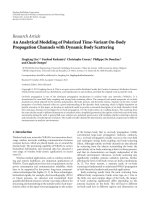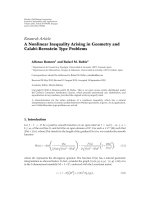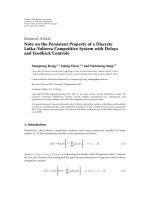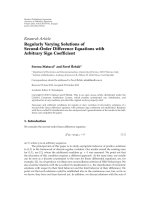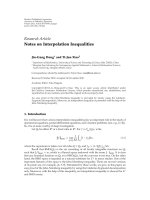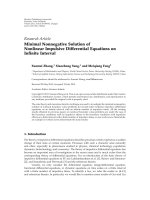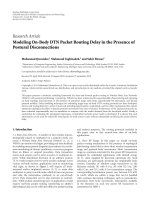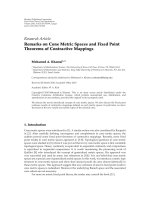Báo cáo hóa học: " Research Article Note on q-Extensions of Euler Numbers and Polynomials of Higher Order" docx
Bạn đang xem bản rút gọn của tài liệu. Xem và tải ngay bản đầy đủ của tài liệu tại đây (489.37 KB, 9 trang )
Hindawi Publishing Corporation
Journal of Inequalities and Applications
Volume 2008, Article ID 371295, 9 pages
doi:10.1155/2008/371295
Research Article
Note on q-Extensions of Euler Numbers and
Polynomials of Higher Order
Taekyun Kim,
1
Lee-Chae Jang,
2
and Cheon-Seoung Ryoo
3
1
The School of Electrical Engineering and Computer Science (EECS), Kyungpook National University,
Taegu 702-701, South Korea
2
Department of Mathematics and Computer Science, KonKuk University,
Chungju 143-701, South Korea
3
Department of Mathematics, Hannam University, Daejeon 306-791, South Korea
Correspondence should be addressed to Cheon-Seoung Ryoo,
Received 1 November 2007; Accepted 22 December 2007
Recommended by Paolo Emilio Ricci
In 2007, Ozden et al. constructed generating functions of higher-order twisted h, q-extension of
Euler p olynomials and numbers, by using p-adic, q-deformed fermionic integral on
Z
p
. By apply-
ing their generating functions, they derived the complete sums of products of the twisted h, q-
extension of Euler polynomials and numbers. In this paper, we consider the new q-extension of Eu-
ler numbers and polynomials to be different which is treated by Ozden et al. From our q-Euler num-
bers and polynomials, we derive some interesting identities and we construct q-Euler zeta functions
which interpolate the new q-Euler numbers and polynomials at a negative integer. Furthermore, we
study Barnes-type q-Euler zeta functions. Finally, we will derive the new formula for “sums of prod-
ucts of q-Euler numbers and polynomials” by using fermionic p-adic, q-integral on
Z
p
.
Copyright q 2008 Taekyun Kim et al. This is an open access article distributed under the Creative
Commons Attribution License, which permits unrestricted use, distribution, and reproduction in
any medium, provided the original work is properly cited.
1. Introduction and notations
Throughout this paper we use the following notations. By
Z
p
we denote the ring of p-adic ra-
tional integers,
Q denotes the field of rational numbers, Q
p
denotes the field of p-adic rational
numbers,
C denotes the complex number field, and C
p
denotes the completion of algebraic clo-
sure of
Q
p
.Letν
p
be the normalized exponential valuation of C
p
with |p|
p
p
−ν
p
p
p
−1
. When
one talks of q-extension, q is considered in many ways such as an indeterminate, a complex
number q ∈
C, or p-adic number q ∈ C
p
. If q ∈ C, one normally assumes that |q| < 1. If q ∈ C
p
,
we normally assume that |q − 1|
p
<p
−1/p−1
so that q
x
exp x log q for |x|
p
≤ 1. In this paper,
we use the following notation:
2 Journal of Inequalities and Applications
x
q
x : q
1 − q
x
1 − q
1.1
cf. 1–5, 22.
Hence, lim
q→1
xx for any x with |x|
p
≤ 1 in the present p-adic case. Let d be a fixed
integer and let p be a fixed prime number. For any positive integer N, we set
X lim
←
N
Z
dp
N
Z
,
X
∗
0<a<d
p
a,p1
a dp
Z
p
,
a dp
N
Z
p
x ∈ X | x ≡ a
mod dp
N
,
1.2
where a ∈
Z lies in 0 ≤ a<dp
N
. For any positive integer N ,
μ
q
a dp
N
Z
p
q
a
dp
N
q
1.3
is known to be a distribution on X cf. 1–20. From this distribution, we derive the p-adic,
q-integral on
Z
p
as follows:
Z
p
fxdμ
q
x lim
N→∞
1
p
N
q
p
N
−1
x0
q
x
fx,f∈ UD
Z
p
, 1.4
see 1–23.
Higher-order twisted Bernoulli and Euler numbers and polynomials are studied by
many authors see for detail 1–21.In14 Ozden et al. constructed generating functions
of higher-order twisted h, q-extension of Euler polynomials and numbers, by using p-adic,
q-deformed fermionic integral on
Z
p
. By applying their generating functions, they derived the
complete sums of products of the twisted h, q-extension of Euler polynomials and numbers,
see 14, 15. In this paper, we consider the new q-extension of Euler numbers and polynomials
to be different which is treated by Ozden et al. From our q-Euler numbers and polynomials,
we derive some interesting identities and we construct q-Euler zeta functions which interpo-
late the new q-Euler numbers and polynomials at a negative integer. Furthermore, we study
Barnes-type q-Euler zeta functions. Finally, we will derive the new formula for “sums of prod-
ucts of q-Euler numbers and polynomials” by using fermionic p-adic, q-integral on
Z
p
.
2. q-extension of Euler numbers
In this section we assume that q ∈
C with |q| < 1. Now we consider the q-extension of Euler
polynomials as follows:
F
q
x, t
2
q
qe
t
1
e
xt
∞
n0
E
n,q
x
n!
t
n
, |t log q| <π. 2.1
Taekyun Kim et al. 3
Note that
lim
q→1
F
q
x, tFx, t
2
e
t
1
e
xt
∞
n0
E
n
x
n!
t
n
. 2.2
In the special case x 0, the q-Euler polynomial E
n,q
0E
n,q
will be called q-Euler numbers.
It is easy to see that F
q
x, t is analytic function in C. Hence we have
∞
n0
E
n,q
x
n!
t
n
2
q
qe
t
1
e
xt
2
q
∞
n0
−1
n
q
n
e
nxt
. 2.3
If we take the kth derivative at t 0onbothsidesin2.3,thenwehave
E
k,q
x2
q
∞
n0
−1
n
q
n
n x
k
. 2.4
From 2.4 we can define q-zeta function which interpolating q-Euler numbers at negative in-
teger as follows.
For s ∈
C, we define
ζ
q
s, x2
q
∞
n0
−1
n
q
n
n x
s
,s∈ C. 2.5
Note that ζ
q
s, x is analytic in complex s-plane. If we take s −k k ∈ Z
, then we have
ζ
q
−k, xE
k,q
x.
By 2.4 and 2.5, we obtain the following.
Theorem 2.1. For k ∈
Z
,
E
k,q
x2
q
∞
n0
−1
n
q
n
n x
k
. 2.6
Let F
q
0,tF
q
t. Then
2
q
n−1
k0
−1
k
q
k
e
kt
2
q
1 qe
t
− 2
q
−1
n
q
n
e
nt
1 qe
t
F
q
t − −1
n
q
n
F
q
n, t.
2.7
From 2.7, derive
∞
k0
2
q
n−1
l0
−1
l
q
l
l
k
t
k
k!
∞
k0
E
k,q
− −1
n
q
n
E
k,q
n
t
k
k!
. 2.8
By comparing the coefficients on both sides in 2.8, we obtain the following.
4 Journal of Inequalities and Applications
Theorem 2.2. Let n ∈
N,k∈ Z
.Ifn ≡ 0 mod 2,then
E
k,q
− q
n
E
k,q
n2
q
n−1
l0
−1
l
q
l
l
k
. 2.9
If n ≡ 1 mod 2,then
E
k,q
q
n
E
k,q
n2
q
n−1
l0
−1
l
q
l
l
k
. 2.10
For w
1
,w
2
, ,w
r
∈ C, consider the multiple q-Euler polynomials of Barnes-type as follows:
F
r
q
w
1
,w
2
, ,w
r
| x, t
2
r
q
e
xt
qe
w
1
t
1
qe
w
2
t
1
···
qe
w
r
t
1
∞
n0
E
n,q
w
1
, ,w
r
| x
t
n
n!
, where max
1≤i≤r
|w
i
t log q| <π.
2.11
For x 0,E
n,q
w
1
, ,w
r
| 0E
n,q
w
1
, ,w
r
will be called the multiple q-Euler
numbers of Barnes type. It is easy to see that F
r
q
w
1
,w
2
, ,w
r
| x, t is analytic function in the
given region. From 2.11,wederive
2
r
q
∞
n
1
, ,n
r
0
−q
r
i1
n
i
e
r
i1
n
i
w
i
xt
∞
n0
E
n,q
w
1
, ,w
r
| x
t
n
n!
. 2.12
By the kth differentiation on both sides in 2.12, we see that
2
r
q
∞
n
1
, ,n
r
0
−q
r
i1
n
i
r
i1
n
i
w
i
x
k
E
k,q
w
1
, ,w
r
| x
. 2.13
From 2.12, we can derive the following Barnes-type multiple q-Euler zeta function as follows.
For s ∈
C, define
ζ
r,q
w
1
,w
2
, ,w
r
| s, x
2
r
q
∞
n
1
, ,n
r
0
−1
n
1
···n
r
q
n
1
···n
r
n
1
w
1
n
2
w
2
··· n
r
w
r
x
s
. 2.14
By 2.13 and 2.14, we obtain the following.
Theorem 2.3. For k ∈
Z
,w
1
,w
2
, ,w
r
∈ C,
ζ
r,q
w
1
,w
2
, ,w
r
|−k, x
E
k,q
w
1
,w
2
, ,w
r
| x
. 2.15
Let χ be the primitive Drichlet character with conductor f odd ∈
N. Then we consider
generalized Euler numbers attached to χ as follows:
F
χ,q
t
2
q
f−1
a0
−1
a
q
a
χae
at
q
f
e
ft
1
∞
n0
E
n,χ,q
t
n
n!
, 2.16
Taekyun Kim et al. 5
where | log q t| <π/f. The numbers E
n,χ,q
will be called the generalized q-Euler numbers
attached to χ.From2.16,notethat
F
χ,q
t
2
q
f−1
a0
−1
a
q
a
χae
at
q
f
e
ft
1
2
q
f−1
a0
−1
a
q
a
χa
∞
n0
q
nf
−1
n
e
anft
2
q
∞
n0
f−1
a0
−1
anf
q
anf
χa nfe
anft
2
q
∞
n0
−1
n
q
n
χne
nt
∞
n0
E
n,χ,q
t
n
n!
.
2.17
Thus,
E
k,χ,q
d
k
dt
k
F
χ,q
t
t0
2
q
∞
n1
−1
n
q
n
χnn
k
, k ∈ N. 2.18
Therefore, we can define the Dirichlet-type l-function which interpolates at negative integer as
follows.
For s ∈
C, we define l
q
s, χ as
l
q
s, χ2
q
∞
n1
−1
n
q
n
χn
n
s
. 2.19
By 2.18 and 2.19, we obtain the following.
Theorem 2.4. For k ∈
Z
,
l
q
−k, χE
k,χ,q
. 2.20
From 2.1 and the definition of q-Euler numbers, derive
F
q
t, x
2
q
qe
t
1
e
xt
∞
n0
E
n,q
t
n
n!
∞
l0
x
l
l!
t
l
∞
m0
m
n0
E
n,q
m
n
x
m−n
t
m
m!
.
2.21
By 2.21 it is shown that
E
n,q
x
n
m0
E
m,q
n
m
x
n−m
,n∈ Z
. 2.22
6 Journal of Inequalities and Applications
For f (=odd) ∈
N,notethat
∞
n0
E
n,q
x
t
n
n!
2
q
qe
t
1
e
xt
2
q
1
q
f
e
ft
1
f−1
a0
−1
a
q
a
e
ax/fft
2
q
2
q
f
f−1
a0
−1
a
q
a
2
q
f
e
ax/fft
q
f
e
ft
1
2
q
2
q
f
f−1
a0
−1
a
q
a
∞
n0
E
n,q
f
a x
f
f
n
t
n
n!
.
2.23
Thus, we have the distribution relation for q-Euler polynomials as follows.
Theorem 2.5. For f (=odd) ∈
N,
E
n,q
x
f
n
2
q
2
q
f
f−1
a0
−1
a
q
a
E
n,q
f
a x
f
. 2.24
For k, n ∈
N with n ≡ 0 (mod 2), it is easy to see that
2
q
n−1
l0
−1
l−1
q
l
l
k
q
n
E
k,q
n − E
k,q
q
n
k
m0
k
m
n
k−m
E
m,q
− E
k,q
q
n
k−1
m0
k
m
E
m,q
n
k−m
q
n
− 1
E
k,q
.
2.25
Therefore, we obtain the following.
Theorem 2.6. For k, n ∈
N with n ≡ 0 (mod 2),
2
q
n−1
l0
−1
l−1
q
l
l
k
q
n
k−1
m0
k
m
E
m,q
n
k−m
q
n
− 1
E
k,q
. 2.26
3. Witt-type formulae on Z
p
in p-adic number field
In this section, we assume that q ∈
C
p
with |1 − q|
p
< 1. g is a uniformly differentiable function
at a point a ∈
Z
p
,andwriteg ∈ UDZ
p
if the difference quotient
F
g
x, y
gx − gy
x − y
3.1
has a limit f
a as x, y→a, a.Forg ∈ UDZ
p
, an invariant p-adic, q-integral is defined as
I
q
g
Z
p
gxdμ
q
x lim
N→∞
1
p
N
q
p
N
−1
x0
gxq
x
. 3.2
Taekyun Kim et al. 7
The fermionic p-adic, q-integral is also defined as
I
−q
g
Z
p
gxdμ
−q
x lim
N→∞
2
q
1 q
p
N
p
N
−1
x0
gx−1
x
q
x
3.3
see 4.
From 3.3, we have the integral equation as follows:
qI
−q
g
1
I
−q
g2
q
g0,g
1
xgx 1. 3.4
If we take gxe
tx
,thenwehave
I
q
e
tx
Z
p
e
xt
dμ
−q
x
2
q
qe
t
1
. 3.5
From 3.5,wenotethat
∞
n0
Z
p
x
n
dμ
−q
x
t
n
n!
2
q
qe
t
1
∞
n0
E
n,q
t
n
n!
. 3.6
By comparing the coefficient on both sides, we see that
Z
p
x
n
dμ
−q
xE
n,q
,n∈ Z
. 3.7
By the same method, we see that
Z
p
e
xyt
dμ
−q
y
2
q
qe
t
1
e
xt
∞
n0
E
n,q
x
t
n
n!
. 3.8
Hence, we have the formula of Witt’s type for q-Euler polynomial as follows:
Z
p
x y
n
dμ
−q
yE
n,q
x,n∈ Z
. 3.9
For n ∈
Z
,letg
n
xgx n.Thenwehave
q
n
I
−q
g
n
−1
n−1
I
−q
g2
q
n−1
l0
−1
n−1−l
q
l
gl. 3.10
If n is odd positive integer, then we have
q
n
I
−q
g
n
I
−q
g2
q
n−1
l0
−1
l
q
l
gl. 3.11
Let χ be the primitive Drichlet character with conduct f odd ∈
N and let gx
χxe
xt
.From3.5 we derive
I
−q
χxe
xt
X
χxe
tx
dμ
−q
x
2
q
f−1
a0
−1
a
q
a
χae
at
q
f
e
ft
1
∞
n0
E
n,χ,q
t
n
n!
.
3.12
Thus, we have the Witt formula for generalized q-Euler numbers attached to χ as follows:
X
χxx
n
dμ
−q
xE
n,χ,q
,n≥ 0. 3.13
8 Journal of Inequalities and Applications
4. Higher-order q-Euler numbers and polynomials
In this section we also assume that q ∈
C
p
with |1 − q|
p
< 1. Now we study on higher-order
q-Euler numbers and polynomials and sums of products of q-Euler numbers. First, we try to
consider the multivariate fermionic p-adic, q-integral on
Z
p
as follows:
Z
p
···
Z
p
r times
e
a
1
x
1
a
2
x
2
···a
r
x
r
t
e
xt
dμ
−q
x
1
···dμ
−q
x
r
2
r
q
qe
a
1
t
1
qe
a
2
t
1
···
qe
a
r
t
1
e
xt
,
4.1
where a
1
,a
2
, ,a
r
∈ Z
p
.
From 4.1 we consider the multiple q-Euler polynomials as follows:
2
r
q
qe
a
1
t
1
qe
a
2
t
1
···
qe
a
r
t
1
e
xt
∞
n0
E
n,q
a
1
,a
2
, ,a
r
| x
t
n
n!
. 4.2
In the special case a
1
,a
2
, ,a
r
1, 1, ,1, we write
E
n,q
a
1
, ,a
r
r times
| x
E
r
n,q
x. 4.3
For x 0, the multiple q-Euler polynomials will be called as q-Euler numbers of order r .
From 4.2 we note that
E
n,q
a
1
,a
2
, ,a
r
| x
Z
p
···
Z
p
r times
a
1
x
1
··· a
r
x
r
x
n
r
j1
dμ
−q
x
j
. 4.4
It is easy to check that
E
n,q
a
1
,a
2
, ,a
r
| x
n
l0
n
l
x
n−l
E
l,q
a
1
,a
2
, ,a
r
, 4.5
where E
n,q
a
1
,a
2
, ,a
r
E
n,q
a
1
,a
2
, ,a
r
| 0. Multinomial theorem is well known as fol-
lows:
r
j1
x
j
n
l
1
, ,l
r
≥0
l
1
···l
r
n
n
l
1
, ,l
r
r
a1
x
l
a
a
, 4.6
where
n
l
1
, ,l
r
n!
l
1
!l
2
! ···l
r
!
. 4.7
By 4.2 and 4.6 we easily see that
E
r
n,q
x
n
m0
l
1
, ,l
r
≥0
l
1
···l
r
m
n
m
m
l
1
, ,l
r
x
n−m
r
j1
E
l
j
,q
. 4.8
Taekyun Kim et al. 9
References
1 M. Cenkci, “The p-adic generalized twisted h,q-Euler-l-function and its applications,” Advanced
Studies in Contemporary Mathematics, vol. 15, no. 1, pp. 37–47, 2007.
2 M. Cenkci and M. Can, “Some results on q-analogue of the Lerch zeta function,” Advanced Studies in
Contemporary Mathematics, vol. 12, no. 2, pp. 213–223, 2006.
3 L C. Jang, S D. Kim, D W. Park, and Y S. Ro, “A note on Euler number and polynomials,” Journal of
Inequalities and Applications, vol. 2006, Article ID 34602, 5 pages, 2006.
4 T. Kim, “A note on p-adic p-integral on
Zp associated with q-Euler numbers,” Advanced Studies in
Contemporary Mathematics, vol. 15, pp. 133–137, 2007.
5 T. Kim, “A note on p-adic invariant integral in the rings of p-adic integers,” Advanced Studies in Con-
temporary Mathematics, vol. 13, no. 1, pp. 95–99, 2006.
6 T. Kim, M. S. Kim, L C. Jang, and S. H. Rim, “New q-Euler numbers and polynomials associated with
p-adic q-integrals,” Advanced Studies in Contemporary Mathematics, vol. 15, pp. 243–252, 2007.
7 T. Kim, “A new approach to q-zeta function,” Advanced Studies in Contemporary Mathematics,vol.11,
no. 2, pp. 157–162, 2005.
8 T. Kim, “A note on exploring the sums of powers of consecutive q-integers,” Advanced Studies in Con-
temporary Mathematics, vol. 11, no. 1, pp. 137–140, 2005.
9 T. Kim, “Sums of powers of consecutive q-integers,” Advanced Studies in Contemporary Mathematics,
vol. 9, no. 1, pp. 15–18, 2004.
10 T. Kim, “q-generalized Euler numbers and polynomials,” Russian Journal of Mathematical Physics,
vol. 13, no. 3, pp. 293–298, 2006.
11 T. Kim, “Multiple p-adic L-function,” Russian Journal of Mathematical Physics, vol. 13, no. 2, pp. 151–157,
2006.
12 T. Kim, “q-Volkenborn integration,” Russian Journal of Mathematical Physics, vol. 9, no. 3, pp. 288–299,
2002.
13 T. Kim, “A note on q-Volkenborn integration,” Proceedings of the Jangjeon Mathematical Society,vol.2,
pp. 45–49, 2001.
14 H. Ozden, Y. Simsek, and I. N. Cangul, “Remarks on sum of products of h,q-twisted Euler polyno-
mials and numbers,” to appear in Journal of Inequalities and Applications.
15 Y. Simsek, “Theorems on twisted L-function and twisted Bernoulli numbers,” Advanced Studies in
Contemporary Mathematics, vol. 11, no. 2, pp. 205–218, 2005.
16 Y. Simsek, “Complete sums of products of h,q-extension of Euler numbers and polynomials,”
preprint, 2007, />17
K. Shiratani and S. Yamamoto, “On a p-adic interpolation function for the Euler numbers and its
derivatives,” Memoirs of the Faculty of Science. Kyushu University. Series A, vol. 39, no. 1, pp. 113–125,
1985.
18 K. Shiratani, “On Euler numbers,” Memoirs of the Faculty of Science. Kyushu University. Series A, vol. 27,
pp. 1–5, 1973.
19 C S. Ryoo, H. Song, and R. P. Agarwal, “On the roots of the q-analogue of Euler-Barnes’ polynomials,”
Advanced Studies in Contemporary Mathematics, vol. 9, no. 2, pp. 153–163, 2004.
20 C S. Ryoo, “A note on q-Bernoulli numbers and polynomials,” Applied Mathematics Letters,vol.20,
no. 5, pp. 524–531, 2007.
21 C S. Ryoo, “The zeros of the generalized twisted Bernoulli polynomials,” Advances in Theoretical and
Applied Mathematics, vol. 1, no. 2-3, pp. 143–148, 2006.
22 C S. Ryoo, T. Kim, and R. P. Agarwal, “Distribution of the roots of the Euler-Barnes’ type q-Euler
polynomials,” Neural, Parallel & Scientific Computations, vol. 13, no. 3-4, pp. 381–392, 2005.
23 C S. Ryoo, T. Kim, and L C. Jang, “Some relationships between the analogs of Euler numbers and
polynomials,” Journal of Inequalities and Applications, vol. 2007, Article ID 86052, 22 pages, 2007.


